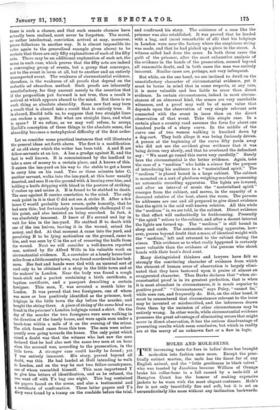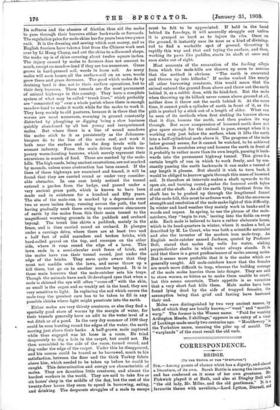MOLES AND MOLE-SKINS.
THE increasing taste for furs in ladies' dress has brought mole-skin into fashion once more. Except the prac- tically extinct marten, the mole has the finest fur of any English animal, and the "little gentleman in black velvet" who was toasted by Jacobites because William of Orange broke his collar-bone in a fall caused by a mole-hill at Hampton Court has the honour of making expensive jackets to be worn with the most elegant costumes. Mole's fur is not only beautifully fine and soft, but it is set on perpendicularly like moss without any inclination backwards. Its softness and the absence of friction -thus aid the moles "to Pass. throug'h their -burrows either backwards or forwards. The regulationprice for mole-skins has for years been two-pence elioh, It' isthe dressing and sewing which coat money, and as English furriers have taken a hint from the Chinese work Sent over by Li Ming Chang, and cut the skins to a diamond shape, the Make -bp is of skins covering about twelve equare inches. The injury caused by moles to farmers does not amount to Much, except on meadow-land if they are too numerous. Grass grows in hard-pressed soil, weeds' in loose soil. As Many moles will soon loosen all the surface-soil on an acre, weeds grow there and grass decreases. The good which moles do by draining land is due, not to their surface operations, but to their -deep burrows. These tunnels, are the most permanent of itninial highways in- this country. They have a complete system of what may be called "trunk lines," which probably are "connected Up" over a whole parish where there is enough meadow-land to make it worth while for the moles to work it. They keep mainly to old pastures, because it is there that the worms are Most numerous, worming in ground constantly disturbed by- ploughing or digging being a slow business quickly abandoned by all but young and inexperienced imam But where there is a line of sound meadows the 'moles stick' to it- as persistently as the Johannes- burgers- do to the line of the main reef, and work it both near the surface and in the deep levels with in. iessant industry. From the main drives they make tem- porary worm-hunting burrows, which merely represent their &Minions in search of food. These are marked by the mole- hills. The high roads, being ancient excavations, are not marked by Mounds, unless some obstruction has been caused. If the lines of these highways are examined and traced, it will be found that - they are carried round or under very consider- able obstacles. In one case lately noticed the tunnel entered a garden from the hedge, and passed under a very ancient grass path, which is known to have been ihade and in existence for a hundred and fifty years. The site of the mole-run is marked by a depression some two or more Moll& deep, running across the path, the turf having gradually* sunk there owing to successive clearances of earth by the moles from this their main tunnel to the magnificent worming grounds in the paddock and orchard beyond. The trunk line skirts a paddock, mainly in the' fence, and is then carried round an orchard. It plunges Under a carriage drive, where there are at least two ' and a half feet of solid maeadam and broken bricks, with hard-rolled gravel on the top, and emerges on the other aide, where it runs round the edge of a lawn. This lawn ends in a semi-circular sunk fence of brick, and the moles have run their tunnel round, just under the edge of f the bricks. They seem quite aware that they must not meddle with the lawn, and never throw up a bill there, but • go on to another meadow beyond. It is in these main burrows that the mole-catcher sets his traps. Though the animals have such ill-developed eyes that when a mole is skinned the eye will often "come off" with the skin, so -small is the organ and so weakly set in the head, they are very sensitive to light. In replacing the sod which covers the mole-trap the greatest care has to be taken to fill in any possible chinks where light might penetrate into the earth.
Either moles are very thirsty creatures, or else they find a specially good store of worms by the margin -of water, for their tunnels generally have an edit to the water level of a wet ditch or of a pond. In the very dry summer of 1899 they could be seen hunting round the edges of the water, the earth moving justabove their backs. A half-grown .mole captured while thus engaged was let loose in a room. He tried desperately to dig a hole in the carpet, but could not. He then scrambled to the side of the room, turned round, and dug under the edge of the carpet. Under this he disappeared, • and'his course could be traced as he burrowed, much to his satisfaction, between the floor and the thick Turkey fabric above him, which needed to be taken up before he could be caught. This determination and energy are characteristic of moles. They are dauntless little creatures, and almost the hardest workers in the world. They are said to take five or sit hours' sleep in the middle of the day, but the rest of the 'twenty-four hours -they seem to -spend in burrowing, eating, 'and drinking. The desperate struggles of a mole to escape
must be felt to be appreciated. If held in the liana behind its fore-legs, it will assuredly struggle out Mileas it is grasped so hard as to injure its ribs. Once on the ground, it instantly uses its nose as a kind of divining. 'rod to find a workable spot of ground, thrusting it rapidly this way and that and trying the surface, and then, working its paws like paddles, starts its shaft at once and soon sinks out of sight.
Most accounts of the excavation of the feeding alleys from which the mole-hills are thrown up seem to assume that the method is obvious. "The earth is excavated and thrown up into hillocks." If moles worked like nearly all other burrowing creatures, this . would mean that the animal entered the ground from above and threw out the earth behind it, as a rabbit does, with its hind-feet. But the mile when throwing up its hillock never comes above ground at all, neither does it throw out the earth behind it. At the same time, it cannot push a cylinder of earth in front of it, as the pith is pushed by a stick out of a length of elder. What can
be seen of its methods when first sinking. its burrow shows
that it digs, loosens the earth, and then pushes its way through. But mere compression of loosened earth does not give space enough for the animal to pass, except when it is working only just below the surface, when it lifts the earth into a half-cylindrical arch above it. The progress of the mole below ground seems, for it cannot be watched, to be achieved
as follows. It scratches away and loosens the earth in front of it probably to rather more than its own length, passing it back.
wards into the permanent highway tunnel. This gives it a certain length of run in which to work freely, and by con. stantly passing the earth backwards it can make a tunnel of any length it pleases. But should it wish to turn back, it would be obliged to burrow again through this mass of loosened soil. It therefore at intervals makes a shaft upwards to the
open air, and turning round, pushes the loosened earth before it out of the shaft. As all the earth lying furthest from the shaft has to be pushed up through the lengthened funnel
of the mole-hill, this must be arduous work. But the enormous strength and resolution of the mole make light of this difficulty. In winter and hard weather they mainly work in banks and in woods and copses. In spring, to use the phrase of the mole.
catchers, they "begin to run," issuing into the fields on every side. Each mole is believed to have a rather elaborate house, which is its head-quarters in winter, where it makes a bed, as described by M. Le Court, who was both a scientific naturalist and also the inventor of the modern iron mole-trap. An
English mole-catcher named Jackson, quoted by Professor Bell, stated that moles dig wells for water, sinking perpendicular shafts in which water always stands. It is said that there is a great predominance of males among moles. But it seems more probable that it is the males which are generally caught. All mole-catchers know that the females are much more difficult to trap, whereas the bulldog courage of the male moles hurries them into danger. They are said to store worms, so bitten as to make them unable to crawl; but this seems uncertain. Their appetite is so voracious that a very short fast kills them. Male moles have been found lying dead by the side of trapped females, the assumption being that grief and fasting have hastened their end.
Moles were distinguished by two very ancient names, by both of which they are locally known,—" want" and "moulde- warp." The former is the Wessex name. "Paid for wanting Ardington Meade, 2 shillings," appears in an entry of a vicar of Lockinge made nearly two centuries ago. " Mouldewarp ig the Yorkshire name, meaning the piler up of mould. The " warplands" of the coast recall the old verb.























































 Previous page
Previous page